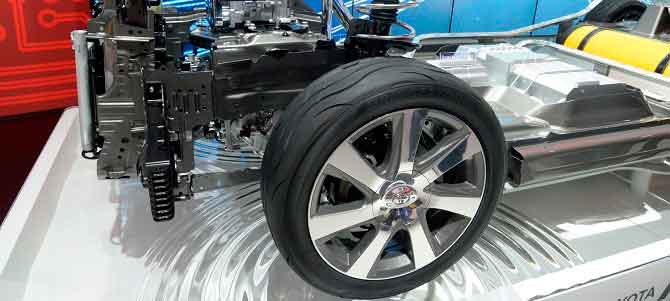Fuel cells are regarded as the technology of the future for both cars and household heating systems. As a result, they have a key role to play in the switch to renewable energies. But are fuel cells always more environmentally friendly? An international team of scientists headed by Empa performed a series of calculations and reached a conclusion: It depends on the fuel. .
In the future, we might be driving fuel-cell cars that burn solar-generated hydrogen. This would make the “zero emissions car” a reality. At the same time, small combined heat and power units – also based on fuel cell technology – could be placed in our cellars at home. They convert natural gas and biogas into electricity while generating heat as an added “bonus” to warm the building.
Although this is technically possible, does it also make sense for the environment? Empa researcher Dominic Notter teamed up with colleagues from Greece and Brazil to analyze the life cycle assessments for the use of fuel cells: From their production, throughout their entire service life, all the way to their eventual recycling.
How the electricity is generated, is the key
The result was conclusive: Fuel cells for cars are only ecologically sound if they are able to run on hydrogen from renewable energy sources. It doesn’t make any sense to draw electricity from the European power grid, use it to produce hydrogen via hydro-electrolysis and fuel cars with it; the CO2 emissions per kilowatt hour of electricity would be far too high using this method. At present, industrial hydrogen is predominantly obtained directly from natural gas. However, the fuel cell does not really have any environmental advantages with this kind of fuel, either. A car with a combustion engine currently has the edge: The production of conventional cars is less harmful for the environment.
Nor does the fuel cell stand a chance in the eco-comparison with electric cars for now: First of all, electricity is needed to generate hydrogen, which the car tanks up on. Electricity is then produced from hydrogen again in the car. This double conversion significantly reduces the efficiency level. People who use the same electricity to charge the battery in their electric cars directly travel more economically and thus in a more environmentally friendly way.
It could be different story in future, however, says Notter. A fuel cell car will become competitive as soon as a company chiefly produces its electricity from solar, wind and hydro power – because the vehicle will guzzle fewer resources during production than a battery-operated electric car, have a far greater range and can be refueled more rapidly.
Combined heat and power units: world champions of energy efficiency
When it came to comparing combined heat and power units, the research team pitted a fuel cell based on state-of-the-art carbon nanotubes against a Stirling engine. This zero-emission machine, which was invented and patented by the Scottish clergyman Robert Stirling in 1816, converts heat into kinetic energy. Both types of combined heat and power unit can be operated with natural gas. The result of the calculation: a slight advantage for the fuel cell as it converts a higher proportion of natural gas into valuable electricity. Anyone who uses it to produce heat and electricity simultaneously exploits 90 percent of the energy contained in the natural gas – a huge proportion. Combined heat and power units – regardless of the type – are therefore masterpieces of energy efficiency. The drawback, however: A fuel cell contains rare metals such as platinum, which are becoming increasingly more expensive and might be difficult to obtain in the future; the Stirling engine, on the other hand, can simply be constructed from steel.
Electric cars with EU electricity not more environmentally friendly than gas-powered cars
For their calculations, Notter and his team used the life cycle assessment instrument, which enables the environmental impact of goods and services to be calculated and compared. The researchers calculated the components of the fuel cells from scratch themselves: For the combined heat and power unit, the fuel cell has an output of 1 kW (kilowatts) and is comparable to a Stirling engine, which generates the same amount of electricity. The fuel-cell vehicle in the study has an output of 55 kW and is comparable to a 55-kW, strong electric car and a small, 55-kW, gasoline-powered car.
The result: Taking the current EU power mix as a comparison, with an assumed consumption of 6.1 l/100 km after 150,000 km of mileage, the gasoline-powered compact car is ahead by a nose. The electric car charged with EU electricity produces slightly more environmental pollution – comparable to 6.4 l/100 km of gasoline consumption. Today, a small fuel-cell car that uses EU electricity to generate hydrogen would easily be the worst option. The car would have the same environmental impact as a luxury sports car with a gasoline consumption of 12.1 l /100 km.
However, the fuel cell could be a key future technology – especially when surplus electricity from wind power and solar energy is stored temporarily in the form of hydrogen and thus becomes accessible for household heating or mobility. Currently, wind farms are simply switched off when there is too much electricity on the market and the eco-energy goes to waste.
Reference(s):
Dominic A. Notter, Katerina Kouravelou, Theodoros Karachalios, Maria K. Daletou, Nara Tudela Haberland. Life cycle assessment of PEM FC applications: electric mobility and μ-CHP. Energy Environ. Sci., 2015
Story: Are fuel cells environmentally friendly? Not always! | Empa — July 15, 2015











Comments